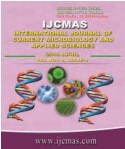


 National Academy of Agricultural Sciences (NAAS)
National Academy of Agricultural Sciences (NAAS)

|
PRINT ISSN : 2319-7692
Online ISSN : 2319-7706 Issues : 12 per year Publisher : Excellent Publishers Email : editorijcmas@gmail.com / submit@ijcmas.com Editor-in-chief: Dr.M.Prakash Index Copernicus ICV 2018: 95.39 NAAS RATING 2020: 5.38 |
Managing agricultural production systems on a sustainable basis is one of the most critical challenges for the future of humanity as the world population is increasing exceptionally. Concepts of modern technologies in agricultural systems have given an important role for the improvement of agricultural productions e.g. crop yield, livestock production, aquaculture production, and sustainable agriculture, in order to maintain food security. Protection of crops against plant diseases, have an evident role to play to meet the rising demand for food quality and quantity (Strange and Scott, 2005). Approximately, direct yield losses caused by pathogens, animals, and weeds, are altogether responsible for losses ranging between 20 and 40 % of global agricultural productivity (Oerke, 2006). Therefore, in order to meet the growing food demand, about 15–20 times increase in the use of synthetic pesticides will be required (Oerke, 2006) but the excessive use of synthetic pesticides is no longer sustainable and causes land, air and water contamination and also responsible for causing resistance development in pathogens and insects as well as adverse impacts on natural enemies and humans (Birch et al., 2011). Due to strong consumer demands to address food security and environmental safety has resulted in the lesser use of synthetic pesticides, the lowering of maximum residue limits and changes in the regulatory environment that favour more environmentally safe control options. Thus there is need to switch for more environmentally safe and ecologically sound pest control methods such as bioagents/biopesticides.
 |
 |
 |
 |
 |